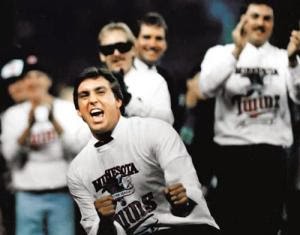![]()
Did the Minnesota Twins luck out in the 1987 World Series, not having to fact the Cards best player? Well...
"Sucks having to watch"
![]()
The re-emergenece of
Allen Craig in the lineup for the St. Louis Cardinals the Red Sox in this year's World Series has some interesting parallels with that of
Jack Clark in 1987. The fortunes of the Cards in this year's Fall Classic hinge heavily upon middle of the order slugger Craig's recuperation from his ankle sprain, just as Clark 's injury impacted St. Louis in '87.
"The Ripper" was hurt on a play at first (see benign mention,
Sept. 9, 1987 news pdf), like Craig (Sept. 4, ankle sprain) this year. Indications are that Craig has sufficiently recovered (that from seeing his first at bat against
Jon Lester in tonight's Game One) enough to be a factor; there was no such prospect for Clark, who had
ligament damage (PDF newspaper report at link). Clark, in fact re-injured himself in a pre-Series workout, all but ending speculation over his availability for St. Louis
| Top 1987 NL MVP Candidates | Games | HRs | RBI | OBP | SLG % | OBP+ | Walks | Total Bases | MVP Vote |
| Jack Clark | 131 | 35 | 106 | 0.459 | 0.597 | 1.056 | 136 | 250 | 3rd |
| | | | | | | | | |
| Andre Dawson | 153 | 49 | 137 | 0.328 | 0.568 | 0.896 | 32 | 353 | 1st |
Andre Dawson won the MVP that year, despite playing for the last-place Chicago Cubs. But, given "The Hawk's" defensive abilities, his "good guy-who-plays-the-game-right" reputation, his truck load of RBIs and homers in (hitter-friendly) Wrigley Field for the sad-ass Cubbies, it was all too
intoxicating for the voters. Dawson was playing in a time when modern metrics weren't given shrift, or were not even in the lexicon. For instance, his wRC (
weighted runs created, 100 being average) was 124 (excellent), while Clark had
176. Read that as "Jack Clark created 76% more runs than the league average in '87." So, who was the better run creator? Who was more valuable? Um, let's see now...
But as
Jack the Ripper (now known better as "The Man Least Likely To Be Asked Out For A Beer By
Albert Pujols") was known as a prickly interview, and a less-than-interested defensive player, the voters gave Dawson the nod. He did not play nice with everyone at all times, an old-school type player who debuted at age 19 in the '75 season with the Gigantes. I present the above stats as another way to look at the voting. And, mainly, to illustrate what an offensive force the Twins avoided.
I feel even the most alcohol-influenced, rabid, bar room '87 Twins fans would agree with me (I think) - I'm basically saying what Cardinals fans have been saying for so many years. The Twins got lucky. No matter that Clark batted .247, with only 13 of his 35 homers versus left handers (see "
Frank Viola"), he still had an excellent .966 OBP against them. It was even better against righties (see "
Bert Blyleven"), it was perverse: a 1.117 OBP, with 22 homers.
Beware Bert, man of 46 homers allowed, 1986
A healthy Clark would have gotten on base somehow, Twins fans, as his bushel basket of walks proves; and getting on base so often begets runs, and forces pitching and defensive mistakes, and on-the-fly managerial adaptations. Manager
Tom Kelly would have had his hands full, decisions, decisions.
This excellent series preview offers a look at how the experts saw it - another larger view of this at
Google docs. You may have guessed - I dig the newspapers, builds my brain.
and the 1972 Oakland Athletics. The "Mustache Gang" won the World Series against the Big Red Machine Reds despite not have Mr. October on the active roster, breaking his ankle in the ALCS against the Detroit Tigers. So, it does not necessarily follow that a resourceful team cannot have other players step up - like
- and fill in gaps.









































_265x395.png)










